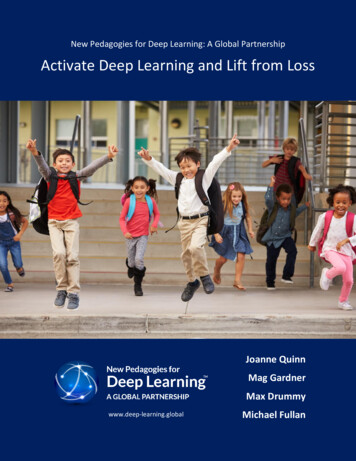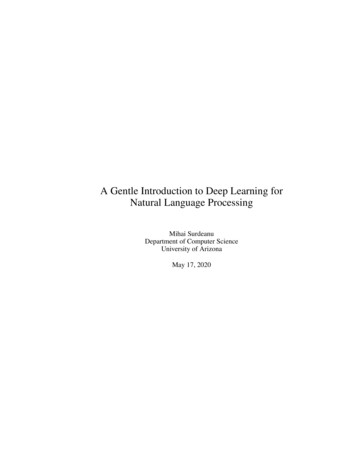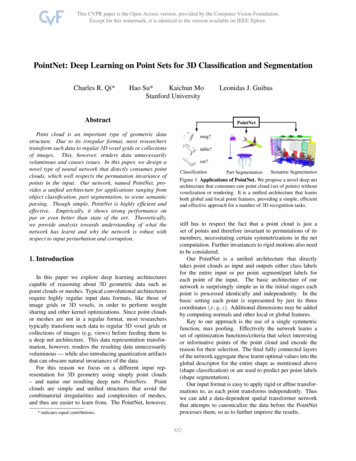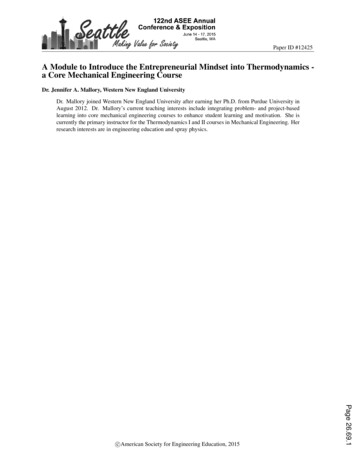
Transcription
New Pedagogies for Deep Learning: A Global PartnershipActivate Deep Learning and Lift from LossJoanne QuinnMag GardnerMax Drummywww.deep-learning.globalMichael Fullan
Ten Priorities to Activate Deep Learning and Lift from LossJoanne Quinn, Mag Gardner, Max Drummy, Michael FullanEnduring the pandemic has been like riding a roller coaster without seatbelts. For most, it's beenan unnerving experience. This year has exposed the inequities of society and education. With anend in sight, it might be tantalizing to dream that we can return to the way we were. Nothingcould be further from the truth. The pandemic’s tentacles have touched everyone in some way.Our neuropathways have been rewired. Trauma, stress, boredom, and inactivity have affectedour cognitive functioning and perpetuated chronic stress.1 We are all different now. By necessityschool has also changed. Schools have embraced new protocols, technology, the outdoors anda focus on well-being. Quite simply, there is no going back because students, teachers, familiesand society are not the same anymore. As Alice Walker says, “You can’t step in the same rivertwice. The river is different and so are you.”Come back anew.Instead, let’s view this period as the clean slate that it can be. Come back anew based on whatwe have learned during this time away. Imagine a school where students walk in and feelwelcome and excited to connect with each other through learning that is relevant andpurposeful. This school is a community of connection, of wonder, of joy. This is a place whereeach student matters-- where equity, well-being and rich, engaging learning liberates eachstudent to flourish.Resist the quick fix.As we welcome students backthere will be many challenges toaddress. One such challenge is“learning loss” as cited by severalauthors.2 Our first instinct may beto triage the ‘loss’ and respondwith testing, streaming, andremediating students as theefficient and obvious solution.However, we strongly cautionagainst this approach. First, it’s anold model that has failed to serveour most vulnerable students. Second, educators cannot assume they know the student now asthey did pre-pandemic. Rushing in with remediation does not respect how the student has grownover the past year. Also, sifting and sorting students purely based on reading and math reinforces1Cushing, E. (2021, March) Late stage pandemic is messing with your brain. The Atlantic. 3(8).Dorn, E., Hancock, B., Sarakatsannis, J., & Viruleg, E. (2020, December 8). Covid-19 and learning loss: Disparitiesgrow and students need help. New York, NY: McKinsey. disparities-grow-and-students-need-help2
damaging social stigma and can pull them away from quality learning experiences that could bedeeply meaningful and highly reflective. Lastly, it is entirely possible that such tone-deafmitigation attempts would further exacerbate an already desperate situation by furtherdiscouraging students from returning to school. We urge schools to resist the temptation to jumpto the ‘quick fix’.Activate Learning.Transition is a massive challenge at this time. However, we must seize this unique moment toactivate the students’ innate desire to connect and be curious through authentic deep learningexperiences. Not only will this re-engage them in school but it will also accelerate the learning asmotivation and engagement combine to lift them from learning loss. Schools and students willthrive when they embrace a unified purpose that focuses on equity, well-being and deeplearning.We propose educators execute 10 priorities to activate deep learning and lift students from theloss they have encountered during this fragile period. These priorities will set schools on thisenergizing path. Copyright 2021 Education in Motion (New Pedagogies for Deep Learning) www.deep-learning.global
Ten Priorities to Activate Deep Learning and Lift from Loss1.Use an Asset LensTreat people like they’re broken, and they will respond as though they are. Use an asset lens byrecognizing strengths and investing belief in them and they will surprise you. Begin by listening to studentvoice. Interview kids to hear their stories, how they have coped, and what they have come to understandabout themselves at this time. Listen and watch for the learning gains rather than the gaps and build onthose. Co-identify new learning possibilities that could inspire them to re-focus on their futures.2. Nurture Well-beingWe cannot all be mental health specialists, but we can all be human. Authentic relationships are key tosupporting our collective well-being. Take dedicated time to nurture meaningful connections withstudents so they know you care. Remind students of the importance of friendship and how to supporteach other. Everyone in the community, staff, students, and parents should be aware of how to recognizetrauma and how, as humans, they can offer support. For those students who are alienated, solidify theconnection with an enduring caring adult who will check in with the student for at least six months.3. Make school a happy placeFor students, being at home has been at its best, lonely. Refresh the school community by restoring joy,color, music, laughter, movement, and celebration. Bring back the heart-warming rituals and sharednorms that generate psychological safety and inclusion. Consider ways to help each student feel special,significant, and that they belong to a community. Make it a place where they want to be. This is not fluffor a detour from the learning. To reach students’ minds, we must pass through their hearts first.4. Ignite their interest through deep learningKnow that fanfare will only take you so far. If the spectre of boredom (such as textbooks, quizzes, andworksheets) haunts the classrooms, students will quickly disengage, and it will be a sure sign that nothinghas authentically changed at school. We need to re-engage students with deep, meaningful, relevantlearning. There is a lot to do here but the simplest way to begin is by incorporating student voice andchoice. Position yourself as a learner by listening to what students are interested in. Model curiosity andtheirs will quickly follow.5. Remember: one size fits no oneWhen you have listened to students’ interests and strengths, meet them where their minds are. This maymean differentiated instruction, purposeful grouping, customized timetabling, individualized support,partnering students with other experts. While this sounds like a lot of work up front, it will reducedisengagement and other concerns later on.6. Don’t track, don’t test, don’t retainTracking, testing and retaining practices hold students back. Students view these as punishment like acurse that keeps on giving. It may happen once but its effects chip away at student confidence andcompetence for a lifetime. Instead, agree as a staff that for one full month, you will delay dispensingjudgment. Suspend practices that alienate students. Instead, substitute with interactive strategies likedescriptive feedback, small group and individual conferencing and self/peer assessment. Then watchstudents bounce to life as they take interest and gain independence in their learning. Copyright 2021 Education in Motion (New Pedagogies for Deep Learning) www.deep-learning.global
7. Don’t migrate from tech - leverage itOur growth in digital competencies has significantly increased our ability to connect and communicate.Consider how parents have become more engaged at this time. Middle and secondary students have hadimproved email access to teacher support. Social media has broadcasted upbeat and hopeful messaging.Through internet, students have been exposed to some of the finest museums, galleries and events in theworld. Collaborative problem-solving meetings are easily conducted by digital. Tech is effective when itmoves beyond mere transmission to foster connection and discovery. Why would we let all this go?8. Forge new pathways for those who need it mostWhen addressing extreme needs, give the student an active voice in the process and solution finding.Collaboratively forge an intentional pathway of support that the student can see themself on. Be open tothe students’ suggestions, no matter how unconventional they may be. Consider a robust range of freshalternatives that gives them hope, optimism and generates commitment. Seize summer opportunities tocatapult curiosity and generate community while facilitating new skills. Pursue other constructivestrategies like: experiential programs, creative time-tabling, credit recovery, waiving prerequisites,granting credit for life skills and work experience can empower students. Invite their feedback. Negotiatehow marks will be generated. These strategies will be interpreted as a handshake rather than a hand-out.9. Create a Hub for AllRoll out the welcome mat for the community by partnering with agencies, public libraries, local businessesand food banks. Make WIFI available to all. Re-examine your facility policies. Strong families are rooted instrong communities. When we nurture relationships with the community and our families, we enableeveryone to be their best. When children see their families invested as a part of the school space, itbecomes a safe and essential space for them too.10. Leave no one behindRemember, that transitions are difficult for everyone, even for seasoned staff. In one year, ourneuropathways have been rewired and returning to face-to-face schooling represents another significantchange. The kids will not be well if adults are not well. Many of these priorities listed above aptly apply tothe adults just as they would to our children.So, this is our chance to come back anew. The pandemic has robbed us of so many lifemoments. Let’s not let it rob schools of this unique opportunity. Embrace these ten prioritiesand forge a pathway to schools of promise and possibility.Kickstart for action .use this paper as a discussion starter with your team.Invite staff to read this paper. Discuss the practices that resonate with your experience.Using this paper as a reference, and given your context, what should your school or district: StopStartContinue Copyright 2021 Education in Motion (New Pedagogies for Deep Learning) www.deep-learning.global
Activate Learning. Transition is a massive challenge at this time. However, we must seize this unique moment to activate the students’ innate desire to connect and be curious through authentic deep learning experiences. Not only will this re-engage t










